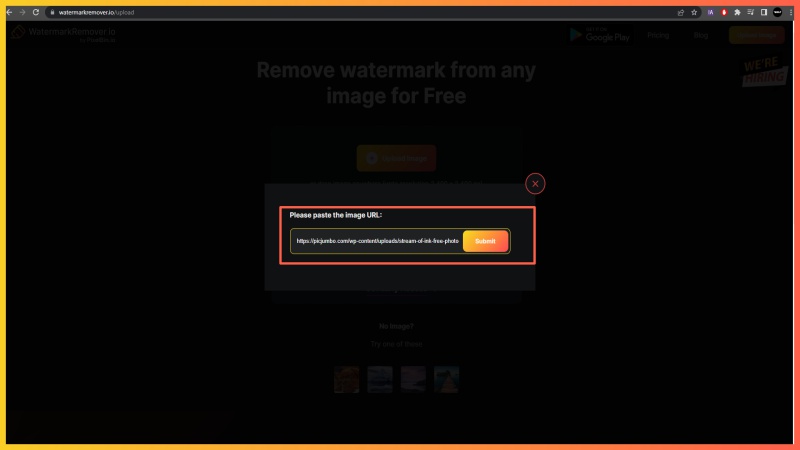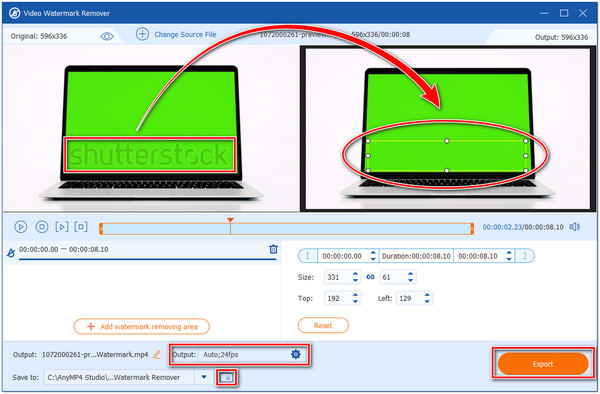If you’ve ever come across a stunning Shutterstock image and thought about using it for your project, you might notice the watermark that’s superimposed over the picture. Watermarks are added to protect the rights of photographers and stock image providers, but sometimes, people wonder if they can remove these marks to use the images freely. While it might seem tempting to find quick fixes online, it’s important to understand what watermarks are and why they exist. In this post, we’ll explore some common methods people talk about for removing watermarks and, more importantly, discuss the right way to handle copyrighted images.
Understanding Legal and Ethical Considerations

Before diving into any techniques for removing watermarks, it’s crucial to understand the legal and ethical landscape. Watermarks are not just decorative; they serve as a clear notice that the image is protected by copyright law. Using an image without proper permission can lead to serious legal consequences, including fines or lawsuits.
Here are some key points to consider:
- Copyright Infringement: Removing a watermark to use an image without paying for it or obtaining permission is considered copyright infringement. This is illegal and unethical.
- Respect for Creators: Photographers and artists put time and effort into creating their work. Respecting their rights means either purchasing the image or using freely licensed alternatives.
- Alternatives to Removal: Instead of trying to remove watermarks, consider these options:
- Buy the licensed, watermark-free version from Shutterstock
- Use free stock image websites like Unsplash or Pexels
- Contact the owner for permission or licensing rights
In summary, attempting to remove watermarks to use images without proper rights is both illegal and unethical. The best approach is to respect copyright laws and seek legitimate ways to access or purchase images. This ensures you stay on the right side of the law and support creators who produce valuable content.
Tools and Software for Watermark Removal

When it comes to removing watermarks from Shutterstock images, there’s no one-size-fits-all solution. Luckily, there are a variety of tools and software out there that can help you get the job done, whether you’re a beginner or a seasoned graphic designer.
Online Tools: These are perfect if you want quick results without installing anything. Some popular options include:
- Inpaint: User-friendly and effective for removing watermarks with just a few clicks. It works well for simple backgrounds and small watermarks.
- Fotor: Offers a clone tool to help blend the watermark into the surrounding area.
- Pixlr: A powerful online editor with advanced tools that can help you remove watermarks manually.
Desktop Software: If you need more control and precision, desktop applications are the way to go. Some top choices include:
- Adobe Photoshop: The industry standard for photo editing. With its clone stamp, healing brush, and content-aware fill, Photoshop can help you seamlessly remove watermarks—though it requires a bit more skill.
- GIMP: A free, open-source alternative to Photoshop. It offers many similar tools for cloning and healing.
- Photopea: A browser-based photo editor that mimics Photoshop’s features, making it accessible without installation.
AI-Powered Tools: Emerging AI-based tools are making watermark removal easier and more efficient. They analyze the image and intelligently fill in the watermark area. Examples include:
- HitPaw Watermark Remover
- Remove.bg (for backgrounds, but can be adapted)
Remember, while these tools can help, the quality of your results depends on the complexity of the watermark and the background. Always use these tools responsibly, respecting copyright laws and licensing agreements.
Step-by-Step Guide to Removing Watermarks Using Photoshop

If you have access to Adobe Photoshop and want to remove a watermark manually, here’s a simple step-by-step guide to help you achieve professional-looking results.
Step 1: Open Your Image
Launch Photoshop and open the Shutterstock image with the watermark you want to remove. Make sure to duplicate the background layer (Right-click on the layer > Duplicate Layer) so you can work non-destructively.
Step 2: Select the Watermark Area
Use the Lasso Tool or Quick Selection Tool to carefully outline the watermark. Take your time to select as precisely as possible. If the watermark is small, the Magic Wand Tool can also be effective.
Step 3: Use the Content-Aware Fill
Once selected, go to Edit > Fill and choose Content-Aware from the dropdown menu. Click OK, and Photoshop will analyze the surrounding pixels to fill in the selected area seamlessly. This is often the best method for removing watermarks because it intelligently blends the area.
Step 4: Refine the Area
After the fill, there might be some imperfections. Switch to the Healing Brush Tool or Clone Stamp Tool to manually fix any irregularities. Carefully sample nearby pixels and paint over the area to blend it naturally with the surroundings.
Step 5: Zoom In and Fine-Tune
Zoom into the edited area to check for inconsistencies. Use smaller brush sizes for detailed work. Pay attention to textures and colors, making sure everything looks natural.
Step 6: Save Your Image
Once satisfied, save your work in the desired format. It’s best to save a copy in PSD format in case you need to make further edits later.
And there you have it! Removing watermarks with Photoshop can be straightforward with some patience and practice. Just remember to always respect copyright laws and use these techniques responsibly.
Alternative Online Tools for Watermark Removal

If you’re looking for quick and easy ways to remove watermarks from Shutterstock images without diving into complex software, there are plenty of online tools that can help. These platforms are user-friendly, often free or offering free trials, and can be a real time-saver. Just keep in mind that the effectiveness of these tools varies, and results might not always be perfect.
Here are some popular online options worth exploring:
- Inpaint Online: A straightforward tool that allows you to upload your image and then use a simple brush to highlight the watermark. It then processes the image and attempts to remove the marked area. It’s great for small watermarks and quick edits.
- Watermark Remover.io: This AI-powered tool automatically detects watermarks and removes them with minimal effort. Upload your image, and it will do the work for you—perfect for bulk processing or when you’re in a hurry.
- Edit Photos for Free: Offers a variety of editing tools, including a clone stamp and healing brush, that can help manually remove watermarks. The interface is intuitive, making it suitable for beginners.
- Fotor: A versatile online photo editor that includes features for removing objects from images. While not specifically designed for watermark removal, its clone and healing tools can be effective if used carefully.
- Pixlr: An advanced online editor with powerful tools similar to Photoshop. It offers a healing brush and clone stamp, which can be used to manually erase watermarks and fill in the background seamlessly.
Remember, while these tools are convenient, the results can vary based on the complexity of the watermark and the background. For professional or high-quality needs, manual editing or dedicated software might still be the way to go. Always test different tools to see which one gives you the best result without compromising the image’s integrity.
Tips for Ensuring Image Quality After Watermark Removal
Removing a watermark is one thing, but maintaining the original quality of the image afterward can be a real challenge. A poorly done removal can leave you with blurry spots, artifacts, or mismatched backgrounds. Here are some practical tips to help ensure your image remains sharp and professional-looking after watermark removal:
- Use High-Resolution Originals: Start with the highest quality version of the image you can find. This gives you more pixels to work with, making it easier to repair or clone areas without losing detail.
- Choose the Right Tool for the Job: Manual editing with tools like Photoshop’s clone stamp or healing brush typically yields better results than automated online removal, especially for complex backgrounds.
- Zoom In and Work Carefully: When editing, zoom in closely to ensure that your repairs blend seamlessly. Take your time to match textures and colors perfectly.
- Pay Attention to Background Consistency: If the background behind the watermark is complex, consider using content-aware fill or advanced cloning techniques to replicate the surrounding area accurately.
- Adjust Colors and Brightness: After removal, you might notice slight color mismatches. Use adjustment layers or filters to fine-tune the image, ensuring a uniform appearance.
- Sharpen the Image if Needed: Sometimes, watermark removal can soften details. Applying a subtle sharpening filter can help restore crispness without introducing noise.
- Save Multiple Versions: Keep different drafts of your edited image. This way, you can compare and choose the best quality version or revert to an earlier step if needed.
- Test Print or View on Different Devices: Before finalizing, check how your image looks on different screens or printed formats. This helps catch any inconsistencies or artifacts you might have missed.
In the end, patience and attention to detail are your best friends when ensuring high-quality results. If you’re not confident in your editing skills, consider consulting a professional or using advanced software that offers more control. Properly restored images not only look better but also uphold your credibility when sharing or publishing your content.
Best Practices for Legally Using Shutterstock Images
When it comes to using Shutterstock images, the most important thing is to stay within the boundaries of copyright law and Shutterstock’s licensing agreements. While it might be tempting to find quick fixes for removing watermarks or using images without proper licensing, it’s essential to remember that doing so can lead to legal trouble. So, let’s talk about some best practices to ensure you’re using images responsibly and legally.
1. Always Purchase the Correct License
- Shutterstock offers various licensing options, including Standard and Enhanced licenses. Make sure to select the one that aligns with your intended use.
- Read the license terms carefully to understand what’s permitted — whether it’s for commercial use, print, or digital distribution.
2. Use Images According to License Terms
- Avoid modifying images in ways that violate license restrictions, such as creating derivative works if not permitted.
- Respect restrictions on redistribution, especially if the license doesn’t allow you to resell or share the image as-is.
3. Keep Proper Records
- Save your purchase receipts and license details. This documentation can be invaluable if your usage is ever questioned.
- Maintain a clear record of which images you’ve licensed and how you’ve used them.
4. Attribute When Necessary
- While Shutterstock images typically don’t require attribution, some third-party images or specific licenses might. Always check the license details.
5. Avoid Watermark Removal Techniques
Trying to remove watermarks without purchasing and licensing the image is not only unethical but also illegal. Instead of risking legal issues, invest in properly licensed images. If you need to modify images, do so within the bounds of your license and Shutterstock’s terms.
6. Use Watermarked Images Only for Preview Purposes
If you are just browsing or preparing a project, Shutterstock provides watermarked preview images. These are meant for review only and should never be used in final products.
By following these best practices, you ensure your image usage remains ethical, legal, and respectful of creators’ rights. It’s always better to play it safe than to face potential legal hassles down the line. Remember, respecting copyright not only keeps you out of trouble but also supports the hardworking photographers and artists behind those beautiful images.
Conclusion and Final Advice on Image Usage
Using images from Shutterstock can really elevate your projects—whether they’re for your website, marketing materials, or social media. However, with great images comes great responsibility. The temptation to remove watermarks or use images without proper licensing might seem like a quick shortcut, but it’s important to remember that these actions can lead to serious legal consequences and damage your reputation.
My final advice? Always prioritize legal and ethical use of images. Purchase the appropriate license, follow the terms carefully, and keep good records of your licenses. If you’re ever unsure about whether your usage is compliant, consult Shutterstock’s licensing guidelines or seek legal advice. Remember, supporting artists and photographers by respecting their work not only keeps you compliant but also fosters a healthy creative community.
For your next project, plan ahead: select the right images, license them properly, and use them responsibly. This approach might take a little extra time or investment, but it’s well worth it in the long run. Happy creating, and always play it safe with your image choices!


